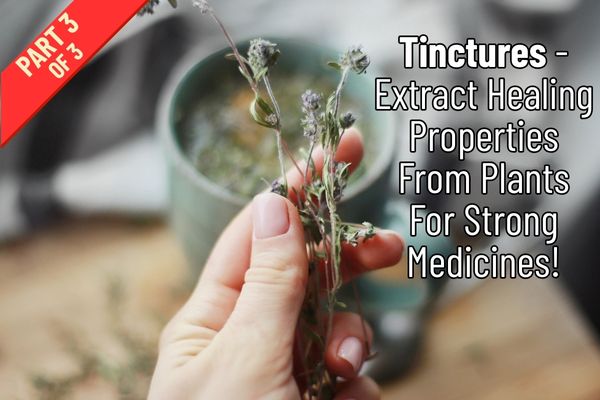In Parts I and II of this series, we covered infusion and decoction fundamentals. Now, in Part III, we’ll focus on tincture preparation – a critical preservation method creating potent, shelf-stable herbal medicines.
Tinctures offer concentrated potency and multi-year storage capability essential for serious preparedness planning.
These concentrates represent a gold standard for herbal preservation, extracting water-soluble and alcohol-soluble compounds while creating preparations that remain potent for decades when properly made. This method becomes invaluable when fresh plants aren’t available or when maximum therapeutic concentration is needed in minimum storage space.
Understanding Tincture Extraction Principles
Tinctures work through alcohol’s ability to dissolve compounds that water cannot effectively extract. Plant alkaloids, resins, essential oils, and therapeutic compounds dissolve readily in alcohol but remain locked in plant tissues during water-only extraction.
Alcohol concentration determines which compounds dissolve most effectively. High-proof alcohol extracts resins, oils, and alcohol-soluble alkaloids, while lower concentrations extract water-soluble compounds like tannins and mucilages. Different plants require different alcohol concentrations for optimal extraction.
Fresh plant tinctures often produce superior results because living cells contain higher concentrations of active compounds. However, properly dried materials create great tinctures when fresh materials aren’t available.
Extended extraction time allows alcohol to penetrate plant tissues completely and dissolve compounds gradually. This gentle and thorough process often produces more complete results than rapid methods, though requiring weeks or months to complete.
Essential Equipment and Materials
Quality alcohol forms the foundation of successful preparation. Grain alcohol, vodka, rum, or brandy work well, with higher proof generally producing stronger extractions. Avoid denatured alcohol, rubbing alcohol, or any alcohol containing additives.
Glass containers are mandatory. Alcohol dissolves compounds from plastic, potentially contaminating preparations. Use wide-mouth canning jars for the process of drawing desired components from plants (maceration), as large openings facilitate material handling.
Straining equipment including fine mesh strainers, cheesecloth, and coffee filters enable thorough separation. Multiple straining stages produce cleaner final products with better storage characteristics.
Dark glass storage bottles protect finished tinctures from light degradation. Amber or cobalt blue bottles work best, though any dark glass provides adequate protection.
Basic Preparation Methods
Folk Method (Simple Ratio)
The folk method uses simple volume ratios without precise measurements, ideal for field conditions. Fill containers one-third full with chopped fresh plant material or one-quarter full with dried material, then cover completely with alcohol.
Add enough alcohol to cover plant material by at least one inch. This compensates for absorption and prevents exposure that could cause spoilage.
Seal containers tightly and store in dark, room-temperature locations. Shake vigorously daily for the first week, then weekly thereafter. Macerate minimum four weeks, though six to eight weeks produces stronger extractions.
Weight-to-Volume Method (Standardized)
Professional herbalists prefer weight-to-volume ratios for consistent results. Common ratios include 1:4 (one part plant to four parts liquid) and 1:5, with alcohol concentrations specified based on plant requirements.
Weigh plant material precisely, then calculate required liquid volume. For 1:4 preparation, 100 grams requires 400ml of alcohol solution. This method produces standardized preparations suitable for consistent dosing and therapeutic reliability.
Fresh plants typically use 1:2 ratios due to water content diluting final alcohol concentration. Dried materials usually require 1:4 or 1:5 ratios for optimal extraction.
Alcohol Concentration Guidelines
High-Alcohol Extractions (75-95%)
:: Resinous plants like pine, spruce, poplar buds
:: Aromatic plants containing essential oils (rosemary, thyme, sage)
:: Some alkaloid-containing plants
Moderate-Alcohol Extractions (50-70%)
:: Most medicinal plants requiring balanced extraction
:: Fresh plant tinctures (compensating for plant water content)
:: Many alkaloid plants like echinacea, goldenseal
Low-Alcohol Extractions (25-40%)
:: Mucilaginous plants (marshmallow root, slippery elm, plantain)
:: Delicate compounds that break down in high alcohol
:: Glycerin tinctures for alcohol-free preparations
Specific Plant Protocols
Echinacea Root Tincture
This preparation is great for supporting and boosting the immune system, helping to fight off colds and flu and reduce inflammation.
Fresh echinacea root produces superior results. Harvest fall roots when compounds peak. Clean thoroughly but don’t peel – compounds concentrate near the surface.
Chop fresh roots finely. Use 1:2 ratio with 70% alcohol. Macerate 6-8 weeks with daily shaking first two weeks. Finished tincture should produce tongue tingling, indicating potency.
Dosage: 30-60 drops 3-4 times daily at illness onset. Continue 7-10 days maximum, then discontinue one week.
Willow Bark Tincture
This is effective as a natural, anti-inflammatory pain reliever for conditions like headaches, arthritis, and back pain.
Harvest inner bark from young branches during spring sap flow. Use 1:4 ratio with 60% alcohol for effective salicin extraction without excessive tannins.
Macerate 8-12 weeks for tough bark material. Finished tincture should taste intensely bitter.
Dosage: 20-40 drops every 4-6 hours for pain or fever. Start with lower doses to assess tolerance.
Calendula Flower Tincture
This tincture is known for its anti-inflammatory, antiseptic, and immune-supportive properties. It is primarily used for soothing skin irritations, promoting wound healing, and supporting the lymphatic and digestive systems.
Fresh flowers create vibrant, active tinctures. Harvest during peak bloom. Use 1:2ratio with 75% alcohol to extract resins and oils.
Macerate 4-6 weeks with frequent shaking. Finished tincture should be bright orange with characteristic aroma.
Usage: Apply externally – 5-10 drops in water for wound washes or direct application to minor cuts.
Dandelion Root Tincture
Want an herbal medicine to help support liver and digestive health? Dandelion Root Tincture helps act as a mild diuretic, and provide a rich source of antioxidants.
Fall-harvested first-year roots contain highest bitter compound concentrations. Clean thoroughly and chop fresh. Use 1:3 ratio with 60% alcohol.
Macerate 6-8 weeks. Finished tincture should be dark brown with intensely bitter taste.
Dosage: 20-30 drops before meals for digestion, or 30-60 drops twice daily for liver support.
Advanced Techniques
Double Extraction Method
Combines alcohol and water extraction for complete therapeutic profiles. Prepare standard alcohol tincture, then create concentrated decoction from spent plant material. Combine finished extractions in 3:1 or 4:1 ratio.
Works well with medicinal fungi like reishi and chaga containing both alcohol-soluble triterpenes and water-soluble polysaccharides.
Percolation Method
Creates stronger tinctures faster through continuous alcohol flow. Pack moistened plant material in percolation cone, allowing alcohol to drip through slowly. Continue until emerging liquid shows little color or taste.
Requires 3-5 times the plant weight in alcohol but reduces time significantly.
Seasonal Considerations and Timing
Understanding seasonal variations dramatically impacts tincture quality and potency. Spring harvests capture rising energy and fresh growth compounds, making them ideal for tonic preparations. Summer collecting during peak flowering provides maximum aromatic compounds and essential oils. Fall root harvesting accesses concentrated storage compounds as plants prepare for dormancy.
Weather conditions before harvest significantly affect compound concentrations. Extended drought stress often increases alkaloid and resin production as plants adapt to challenging conditions. Post-rain harvesting may yield diluted preparations due to increased plant water content.
Time of day affects compound levels in many medicinal plants. Alkaloids often concentrate during early morning hours, while essential oils peak during mid-morning warmth. Understanding these patterns enables strategic harvest timing for maximum therapeutic value.
Troubleshooting Common Problems
Cloudy tinctures indicate incomplete extraction or contamination issues. Insufficient alcohol content fails to preserve properly, leading to bacterial growth and spoilage. Temperature fluctuations during storage cause expansion and contraction, potentially compromising seal integrity.
Weak extraction results from inadequate plant-to-alcohol ratios, insufficient maceration time, or using poor-quality dried materials. Old plant material loses potency over time, producing inferior preparations regardless of proper technique.
Contamination sources include dirty equipment, moisture exposure, or using compromised plant materials. Prevention requires strict sanitation protocols and quality control throughout the entire process.
Quality Control and Testing
Establishing consistent quality standards ensures reliable therapeutic results across different batches. Visual assessment includes color intensity, clarity, and absence of unwanted particles or separation.
Organoleptic testing evaluates aroma strength, flavor intensity, and characteristic plant tastes.
pH testing provides additional quality indicators, as properly extracted tinctures maintain predictable acidity levels. Alcohol content verification using hydrometers confirms adequate preservation strength and prevents spoilage during long-term storage.
Documentation systems tracking harvest dates, extraction methods, and storage conditions enable pattern recognition for optimizing future preparations. Batch numbering and quality records create accountability systems essential for medicinal applications.
Quality Assessment
Visual Indicators
:: Strong colors characteristic of source plants indicate proper extraction
:: Clear tinctures without sediment show good filtration
:: Separation suggests incomplete mixing or incompatible ratios
Taste and Aroma
:: Strong, characteristic plant flavors indicate successful extraction
:: Balanced alcohol burn with plant flavors
:: Weak or off-flavors suggest poor quality or inadequate extraction
Storage and Preservation
Store in dark glass bottles in cool, dark locations away from temperature fluctuations. Properly made tinctures remain potent 5-10 years when stored correctly.
Label completely with plant name, preparation date, alcohol percentage, and safety information. Maintain inventory records for production scheduling. Check stored tinctures annually for degradation signs including color changes, sediment, or off odors.
Integration with Preparedness Strategy
Resource Planning
Calculate alcohol needs based on planned production and storage goals. High-proof grain alcohol provides best extraction but may face legal restrictions in some areas. Balance tincture preparation with other preservation methods based on resources and storage capacity.
Complementary Methods
Use tinctures alongside decoctions for comprehensive coverage. Tinctures provide concentrated, portable medicine ideal for limited storage situations, while decoctions offer immediate preparation when time allows. Plan preparation schedules utilizing seasonal plant availability and time resources.
Safety and Legal Considerations
Understand local alcohol regulations regarding purchase, possession, and use. Document medicinal use if questioned by authorities.
Never use denatured or rubbing alcohol for internal tinctures. Test new preparations with small doses before therapeutic amounts. Maintain clear labeling and storage away from children.
Last Thoughts
Tincture preparations provide a strong potency and long storage life indispensable for serious preparedness. Success requires understanding alcohol extraction principles, using appropriate concentrations for different plants, and maintaining patience during extended maceration.
For dedicated preppers, mastering tincture preparation represents the pinnacle of self-reliance. These concentrated, shelf-stable preparations provide decades of therapeutic capability in compact space, creating more medical independence especially during times of infrastructural stability.




